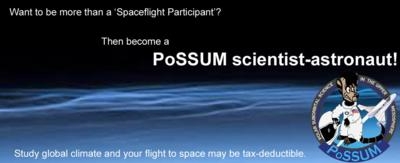Project PoSSUM To Hold Inaugural Qualification Program This February At ERAU In Daytona Beach, FL
Project PoSSUM, a non-profit suborbital research program, announces the first PoSSUM scientist-astronaut class to be held at the Embry Riddle Aeronautical University in Daytona Beach, FL, Feb. 7 - 10, 2015. This unique opportunity allows individuals to train with some of the world’s leading upper atmospheric scientists and to fly to space as part of an international research campaign dedicated to the study of global climate. The four-day, fully immersive qualification program was designed by former NASA astronaut instructors to provide its candidates with the skills required to effectively conduct research on commercial space vehicles as part of Project PoSSUM.

PoSSUM, an acronym for Polar Suborbital Science in the Upper Mesosphere, uses commercial suborbital spacecraft and high-altitude manned balloons to study rare “space clouds” called noctilucent clouds. These elusive clouds can help scientists address critical questions about the Earth’s climate, but they can only be seen from polar latitudes during a small window of time in the summer.
Twelve initial astronaut candidates will learn how to image noctilucent clouds using a customized imagery system called ‘PoSSUMCam’, operate PoSSUM remote-sensing instruments, and recognize cloud features of the greatest scientific interest. The candidates will also receive crew resource management training through custom simulation designed in collaboration with Embry Riddle and Sundog Software. Candidates receive further instruction in spacesuit operations, high-altitude environments, and high-g operations. Upon graduation, candidates will be fully trained and qualified to fly to space as part of a PoSSUM deployment.
“PoSSUM is not about space tourism. PoSSUM is about realizing the new opportunities presented by commercial manned spacecraft to enable science of global benefit. PoSSUM is about engaging and educating people about the pivotal role that our atmosphere plays in the study of global climate. Every PoSSUM scientist-astronaut is an ambassador of this mission,” said PoSSUM Principal Investigator Dr. Jason Reimuller.
PoSSUM evolved from the Noctilucent Cloud Imagery and Tomography experiment, selected by NASA’s Flight Opportunities Program in March 2012 as experiment 46-S. Among those candidates that will train in February will be Cosmonaut Ronnie Nader and a team from Ecuador, who will be modeling elements for their own national space program from the PoSSUM program.
The PoSSUM noctilucent cloud research campaigns are currently scheduled to begin in July 2016, and the scientist-astronauts that complete the program will be a part of the first group of astronauts qualified to fly over Earth’s polar latitudes, where noctilucent clouds and aurora are present, using either a manned reusable suborbital vehicle, such as the XCOR Lynx, or a high-altitude manned balloon. Never before has an astronaut or cosmonaut flown over polar latitudes.
 ANN's Daily Aero-Linx (05.02.24)
ANN's Daily Aero-Linx (05.02.24) ANN's Daily Aero-Term (05.02.24): Touchdown Zone Lighting
ANN's Daily Aero-Term (05.02.24): Touchdown Zone Lighting Aero-News: Quote of the Day (05.02.24)
Aero-News: Quote of the Day (05.02.24) ANN FAQ: Contributing To Aero-TV
ANN FAQ: Contributing To Aero-TV NTSB Final Report: Cirrus Design Corp SR20
NTSB Final Report: Cirrus Design Corp SR20



